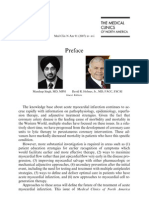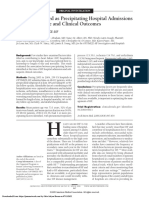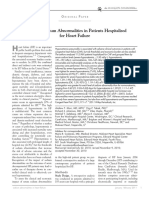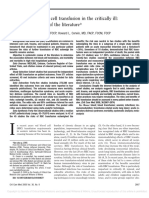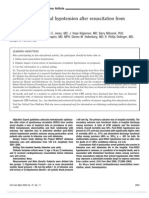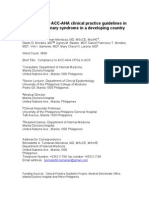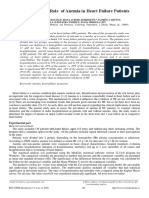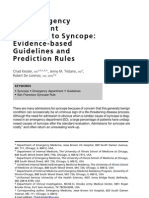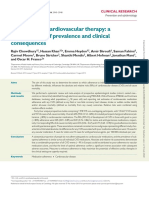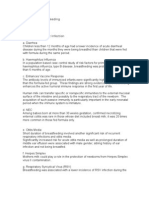Hospitalizations After Heart Failure Diagnosis: A Community Perspective
Hospitalizations After Heart Failure Diagnosis: A Community Perspective
Uploaded by
feranofiartikaCopyright:
Available Formats
Hospitalizations After Heart Failure Diagnosis: A Community Perspective
Hospitalizations After Heart Failure Diagnosis: A Community Perspective
Uploaded by
feranofiartikaOriginal Title
Copyright
Available Formats
Share this document
Did you find this document useful?
Is this content inappropriate?
Copyright:
Available Formats
Hospitalizations After Heart Failure Diagnosis: A Community Perspective
Hospitalizations After Heart Failure Diagnosis: A Community Perspective
Uploaded by
feranofiartikaCopyright:
Available Formats
Journal of the American College of Cardiology 2009 by the American College of Cardiology Foundation Published by Elsevier Inc.
Vol. 54, No. 18, 2009 ISSN 0735-1097/09/$36.00 doi:10.1016/j.jacc.2009.08.019
QUARTERLY FOCUS ISSUE: HEART FAILURE
Hospitalizations After Heart Failure Diagnosis
A Community Perspective
Shannon M. Dunlay, MD,* Margaret M. Redeld, MD,* Susan A. Weston, MS, Terry M. Therneau, PHD, Kirsten Hall Long, PHD, Nilay D. Shah, PHD, Vronique L. Roger, MD, MPH* Rochester, Minnesota
Objectives Background Methods
The purpose of this study was to determine the lifetime burden and risk factors for hospitalization after heart failure (HF) diagnosis in the community. Hospitalizations in patients with HF represent a major public health problem; however, the cumulative burden of hospitalizations after HF diagnosis is unknown, and no consistent risk factors for hospitalization have been identied. We validated a random sample of all incident HF cases in Olmsted County, Minnesota, from 1987 to 2006 and evaluated all hospitalizations after HF diagnosis through 2007. International Classication of Diseases-9th Revision codes were used to determine the primary reason for hospitalization. To account for repeated events, Andersen-Gill models were used to determine the predictors of hospitalization after HF diagnosis. Patients were censored at death or last follow-up. Among 1,077 HF patients (mean age 76.8 years, 582 [54.0%] female), 4,359 hospitalizations occurred over a mean follow-up of 4.7 years. Hospitalizations were common after HF diagnosis, with 895 (83.1%) patients hospitalized at least once, and 721 (66.9%), 577 (53.6%), and 459 (42.6%) hospitalized 2, 3, and 4 times, respectively. The reason for hospitalization was HF in 713 (16.5%) hospitalizations and other cardiovascular in 936 (21.6%), whereas over one-half (n 2,679, 61.9%) were noncardiovascular. Male sex, diabetes mellitus, chronic obstructive pulmonary disease, anemia, and creatinine clearance 30 ml/min were independent predictors of hospitalization (p 0.05 for each). Multiple hospitalizations are common after HF diagnosis, though less than one-half are due to cardiovascular causes. Comorbid conditions are strongly associated with hospitalizations, and this information could be used to dene effective interventions to prevent hospitalizations in HF patients. (J Am Coll Cardiol 2009;54:1695702) 2009 by the American College of Cardiology Foundation
Results
Conclusions
An estimated 5.3 million Americans are living with heart failure (HF), and its prevalence has risen (1). Although improvements in mortality after HF diagnosis have been noted (2,3), hospitalizations related to HF have increased from an estimated 400,000 discharges in 1979 to nearly 1.1 million in 2005 (1). With growing numbers of patients living with HF and increasing hospitalizations, HF costs are signicant, with 2008 U.S. estimated costs of $34.8 billion (1). Thus, HF constitutes a major public health problem, a
large component of which is related to hospitalizations. Yet, little is known about the natural history of hospitalizations after diagnosis of HF. Further, data on the cause of hospitalization after HF diagnosis are sparse. Finally, it has been recently underscored that no consistent predictors of hospitalization in patients with HF have emerged, which hinders the development of effective interventions (4).
See page 1703
From the *Division of Cardiovascular Diseases and Department of Health Sciences Research, Mayo Clinic, Rochester, Minnesota. This study was funded by a National Institutes of Health RO1 Grant (HL72435) to Dr. Roger, an American Heart Association Postdoctoral Fellowship Award to Dr. Dunlay, and a National Institutes of Health Ruth L. Kirschstein National Research Service Award (T32 HL0711131A1) to Dr. Dunlay and was made possible by the Rochester Epidemiology Project (Grant #R01-AR30582 from the National Institute of Arthritis and Musculoskeletal and Skin Diseases). Manuscript received May 6, 2009; revised manuscript received August 25, 2009, accepted August 30, 2009.
Although important knowledge has been gained from patients enrolled in HF clinical trials and from databases comprised of patients hospitalized with HF, these studies cannot fully appraise the total burden of hospitalization in patients with HF. Indeed, patients enrolled in clinical trials differ from the community because they are younger, more frequently male, and have low ejection fraction (EF) (5). Further, large HF registries and databases focus only on patients who have
1696
Dunlay et al. Hospitalization After Heart Failure
JACC Vol. 54, No. 18, 2009 October 27, 2009:1695702
already been hospitalized for decompensated HF (6 8) who may not represent the community, as CI condence interval hospitalization for HF has been COPD chronic shown to be a poor prognostic sign obstructive pulmonary (9,10), and these patients may be disease at higher risk for subsequent HF EF ejection fraction hospitalizations (11). Finally, the HF heart failure use of prevalent cases and analysis HR hazard ratio of only short-term rehospitalizaICD-9 International tion prevents examination of the Classication of Diseasescumulative lifetime burden of hos9th Revision pitalizations in patients after initial HF diagnosis. To address these gaps in knowledge, we undertook the present study of incident HF cases diagnosed from 1987 through 2006 in a stable community setting to examine the frequency and causes of all hospitalizations that occurred over the course of a lifetime after HF diagnosis and whether changes have occurred over time. Second, we determined the risk factors for hospitalization after HF diagnosis.
Abbreviations and Acronyms
Methods Study design and setting. This study was conducted in Olmsted County, Minnesota, which has an estimated 2006 population of 137,521, 90% of whom are Caucasian. Population-based research is possible because there are few health care providers; the largest is Mayo Clinic. Medical records from all sources of care for residents are extensively indexed and linked via the Rochester Epidemiology Project (12). Herein, all patient-level information was obtained via the medical and administrative records. Patients were excluded from analysis if they declined to provide Minnesota Research Authorization. Studies were approved by the Mayo Clinic and Olmsted Medical Center institutional review boards. Patient identication. Olmsted County residents with a possible HF diagnosis were identied using International Classication of Diseases-9th Revision (ICD-9) code 428 (HF). Codes are assigned based on physician diagnoses during outpatient visits or at hospital discharge. From all patients with ICD-9 code 428, a subset was randomly selected to undergo case validation and data abstraction. The HF index date was dened as the rst evidence of HF in the medical record. Patients diagnosed with HF prior to the study period were excluded. Cases were validated using methods previously described (2). Abstractors reviewed records to ensure the HF episode met Framingham criteria. When utilized previously, missing data were minimal, and Framingham criteria could be applied in 98% of cases. The interabstractor agreement was 100%, indicating that these methods are highly reproducible. Patient-level data. Baseline characteristics were abstracted from the medical record. Physicians diagnosis was used to dene hyperlipidemia, chronic obstructive pulmonary dis-
ease (COPD), cerebrovascular disease, and peripheral vascular disease. Smoking status was classied as current or prior/never. Hypertension was dened by physician diagnosis, systolic blood pressure 140 mm Hg, or diastolic blood pressure 90 mm Hg. Diabetes mellitus was dened by blood glucose levels based on year-specic National Diabetes Data Group criteria (glucose 140 mg/dl since May 1972, 120 mg/dl from December 1958 to April 1972, and 130 mg/dl before December 1958) or use of diabetic medications. Prior myocardial infarction was dened using validated criteria (13). Body mass index was calculated using weight and height at HF diagnosis. The Charlson Index, a comorbidity score, was calculated (14). Hemoglobin, creatinine, and EF at HF diagnosis (within 1 year) were abstracted. Anemia was dened as hemoglobin 13 mg/dl in men or 12 mg/dl in women (15). Creatinine clearance was estimated using the Modication of Diet in Renal Disease equation (16). Study outcomes. Data on all-cause hospitalizations occurring after HF diagnosis from 1987 through 2007 were obtained through the Olmsted County Healthcare Expenditure and Utilization Database, which contains information regarding Olmsted County hospitalizations since 1987. For patients hospitalized at initial HF diagnosis, only subsequent hospitalizations were analyzed. In-hospital transfers or between the Olmsted Medical Center and Mayo Clinic hospitals were considered a single hospitalization. Hospital admissions within 1 day of the previous discharge were reviewed to determine whether they represented separate hospitalizations. The principal diagnosis for each hospitalization was assessed using the primary ICD-9 code. This code, assigned by trained personnel after discharge, reects the main reason for admission. Subsequent ICD-9 codes were not examined, as there is discretion in their number and order. The primary reason for hospitalization was divided into 1 of 3 categories (17,18): HF (ICD-9 codes, see the Online Appendix), other cardiovascular (ICD-9 390 through 459 except those used to dene HF), or noncardiovascular (all other ICD-9 codes). Noncardiovascular codes were further grouped by type of problem. Mortality follow-up occurred via the medical record. In addition to deaths noted in clinical care, the Mayo Clinic registration ofce records obituaries and local death notices, and death data are obtained from the State of Minnesota Department of Vital and Health Statistics quarterly. Statistical analysis. Baseline patient characteristics are presented as percentages or mean (SD). Differences in baseline characteristics by sex were tested using the chi-square test for categorical variables or a 2-sample t test for continuous variables. The rate of hospitalization was examined by year of HF diagnosis (1987 through 1991, 1992 through 1996, 1997 through 2001, and 2002 through 2006) or by sex and was determined using the total hospitalizations divided by the person-years at risk for hospitalization. Differences were tested using Poisson regression. Trends in the length of stay
JACC Vol. 54, No. 18, 2009 October 27, 2009:1695702
Dunlay et al. Hospitalization After Heart Failure
1697
Baseline Characteristics Table 1 Patient Baseline Patient Characteristics
Missing Age (yrs) EF (%) Inpatient at HF diagnosis Year of HF diagnosis 19871991 19921996 19972001 20022006 Risk factors and comorbidities Hypertension Current smoker Hyperlipidemia Diabetes mellitus Body mass index (kg/m2) Prior MI COPD Cerebrovascular disease Peripheral vascular disease Charlson index 3 Laboratory data Anemia Creatinine clearance (ml/min) 15 10 43.9 58.2 (21.6) 45.0 60.9 (22.8) 42.9 56.0 (20.2) 0.50 0.001 12 2 17 4 1 5 74.6 14.2 44.3 21.1 29.4 (10.1) 20.1 23.5 24.6 22.0 43.0 65.9 19.1 49.1 23.7 30.0 (10.2) 24.9 26.9 24.0 26.5 46.1 82.0 10.1 40.2 18.9 28.8 (10.0) 16.0 20.6 25.1 18.2 40.3 0.001 0.001 0.003 0.06 0.001 0.001 0.02 0.68 0.001 0.06 20.8 26.1 26.5 26.6 21.0 26.3 27.7 25.1 20.6 25.9 25.4 28.0 0.70 281 Overall (n 1,077) 76.8 (12.7) 46.3 (17.5) 56.0 Men (n 495) 73.3 (12.8) 41.6 (15.9) 55.6 Women (n 582) 79.8 (11.8) 50.6 (17.8) 56.3 p Value 0.001 0.001 0.82
All values are % or mean (SD). COPD chronic obstructive pulmonary disease; EF ejection fraction; HF heart failure; MI myocardial infarction.
according to year and differences by sex were analyzed using generalized linear models; length of stay was log transformed in analysis. The reason for hospitalization was examined overall, by year of HF diagnosis, and by sex. Trends in the reason for hospitalization by year of HF diagnosis were examined using the Mantel-Haenszel chisquare test; differences by sex were tested using the chisquare test. Andersen-Gill models (19) were used to identify the independent predictors of hospitalization. This technique allows all hospitalizations to be analyzed, in contrast to Cox modeling used in most studies that only consider the rst hospitalization. Patients were censored at death or last follow-up. Missing data was 2% per variable with the exception of EF (n 281 missing). Multiple imputation was used to impute missing values. Five datasets were created and analyzed, with results combined using Rubins rules (20). Analyses were performed using SAS version 8.2 (SAS Institute Inc., Cary, North Carolina) and S-PLUS version 8 (TIBCO Software Inc., Palo Alto, California). A p value of 0.05 was used as the level of signicance. Results Study population. A total of 1,091 patients with incident HF were identied from 1987 through 2006. Fourteen patients, hospitalized at initial HF diagnosis, died during that hospitalization and were excluded from analysis as they were ineligible for subsequent hospitalizations, resulting in a study population of 1,077. The baseline characteristics are shown in Table 1. Compared with patients with reduced EF
(50%), patients with preserved EF (50%) were slightly older (77.8 vs. 77.3 years for preserved vs. reduced EF, respectively; p 0.001) and more likely female (58.6% vs. 36.8% for preserved vs. reduced EF, respectively; p 0.001). The proportion of patients with a Charlson comorbidity index 3 increased over the study period (p 0.001). Hospitalizations after HF diagnosis. A total of 4,359 hospitalizations occurred during a mean (SD) follow-up of 4.7 (3.9) years. At study end, 798 (74.1%) patients had died. Hospitalizations after HF diagnosis were common (Fig. 1) and ranged from 0 to 42 (median: 3) per person. A similar
Figure 1
Number of Hospitalizations Per Person After HF Diagnosis
The number of hospitalizations per individual from heart failure (HF) diagnosis until death or last follow-up are shown.
1698
Dunlay et al. Hospitalization After Heart Failure
JACC Vol. 54, No. 18, 2009 October 27, 2009:1695702
Figure 2
Number of Hospitalizations in the Year Prior to Death
The number of heart failure (HF) and non-HF hospitalizations in the year before death among patients who died during follow-up (n 798) are shown.
distribution was observed among those who died, where hospitalizations ranged from 0 to 42 (median: 4) per person, indicative of lifetime hospitalizations after HF diagnosis. A total of 895 (83.1%) patients were hospitalized at least once, and 721 (66.9%), 577 (53.6%), and 459 (42.6%) were hospitalized 2, 3, and 4 times, respectively. Both HF and non-HF hospitalizations increased in the months prior to death (Fig. 2). The mean rate of hospitalization was 86.6 per 100 person-years (95% condence interval [CI]: 84.0 to 89.2). Thus, for each year after HF diagnosis, patients were hospitalized 0.87 times on average, or nearly once per year. Men were hospitalized more frequently, with 92.0 hospitalizations per 100 person-years (95% CI: 88.2 to 95.9) compared with 81.8 hospitalizations per 100 person-years (95% CI: 78.4 to 85.3) for women (p 0.001). The rate of hospitalization after HF did not change over time. The median length of stay per hospitalization was 5 (25th, 75th percentile: 3, 7) days. The length of stay declined over the study period, with median values of 6, 5, 5, and 4 days for hospitalizations from 1987 through 1991, 1992 through 1996, 1997 through 2001, and 2002 through 2007, respectively (p for trend 0.001). Length of stay was
similar among men and women (median: 5 days vs. 5 days, p 0.40). Primary reason for hospitalization. ICD-9 codes were missing in 31 of 4,359 (1%) hospitalizations, leaving 4,328 included in the reason for hospitalization analysis (Table 2). HF was the primary reason for hospitalization in 713 (16.5%) hospitalizations, whereas 936 (21.6%) were due to other cardiovascular causes. Most hospitalizations (n 2,679, 61.9%) were due to noncardiovascular causes. The primary cause of hospitalization did not differ by sex (p 0.106), but changed over time (p 0.001), with a decrease in the proportion of hospitalizations due to HF noted. The most common reasons for other cardiovascular hospitalizations were ischemic heart disease (ICD-9 410 through 414: 299 of 936 hospitalizations, 31.9%) and arrhythmias (ICD-9 427: 249 of 936 hospitalizations, 26.6%). Reasons that accounted for 1% of noncardiovascular hospitalizations are shown in Table 3. Respiratory tract infections, chronic lung disease, and other respiratory symptoms accounted for a large proportion of noncardiovascular hospitalizations (30.4%). Bone and joint diseases accounted for an additional 11.0%. Comorbidities frequent in HF patients, including kidney disease, psychiatric disease, and diabetes mellitus, were additional common reasons for hospitalization. HF hospitalizations. Although only 713 (16.5%) hospitalizations were due to HF, these were clustered among a fraction of the cohort, with just 348 of 1,077 (32.3%) patients ever having an HF hospitalization after diagnosis (hospitalization at the time of incident HF diagnosis excluded). Overall, 39.8% of patients with EF 50% were hospitalized for HF at least once compared with 34.0% of patients with EF 50% (p 0.069). Among the 348 with an HF hospitalization, the number of HF hospitalizations ranged from 1 to 21, and 205 (58.9%) had 1, 67 (19.3%) had 2, and 76 (21.8%) had 3 or more. The incident HF patients with 2 or more HF hospitalizations (n 143) accounted for the majority of HF hospitalizations (508 of 713, 71.2%). They were younger than the rest of the cohort (mean age 74.0 years vs. 77.2 years, p 0.001), had higher body mass
Primary Cause of Hospitalization According toAccording Year of Diagnosis and Sex Table 2 Primary Cause of Hospitalization to Year of Diagnosis and Sex
Type of Hospitalization, n (%) HF Overall Year of HF diagnosis 19871991 19921996 19972001 20022006 Sex Male Female
CV cardiovascular; HF heart failure.
Other CV 936 (21.6)
Non-CV 2,679 (61.9)
Total Hospitalizations 4,328
p Value 0.001
713 (16.5)
210 (19.4) 225 (16.8) 184 (15.7) 94 (12.8)
200 (18.5) 299 (22.3) 288 (24.6) 149 (20.3)
670 (62.0) 819 (61.0) 699 (59.7) 491 (66.9)
1,080 1,343 1,171 734 0.11
359 (16.7) 354 (16.3)
492 (22.9) 444 (20.4)
1,302 (60.5) 1,377 (63.3)
2,153 2,175
JACC Vol. 54, No. 18, 2009 October 27, 2009:1695702
Dunlay et al. Hospitalization After Heart Failure
1699
Primary Cause of Noncardiovascular Hospitalizations Based on ICD-9 Codes Table 3 Primary Cause of Noncardiovascular Hospitalizations Based on ICD-9 Codes
% of Total Hospitalizations (n 4,328) 9.2% 5.9% 3.7% % of Non-CV Hospitalizations (n 2,679) 14.9% 9.5% 6.0%
Primary Cause* Respiratory Respiratory tract infections Chronic lung disease Respiratory symptoms, other Musculoskeletal Bone disorders/fracture Joint disorders/osteoarthritis Gastrointestinal Intestinal disorders Esophagus/stomach/duodenum disorders Liver, gallbladder, pancreas disorders Gastrointestinal bleed Kidney/ureter/bladder disorder including acute renal failure Cancer/benign tumors Procedural/other medical complications General symptoms Fluid and electrolyte disorders Nonrespiratory infections Cellulitis/skin infections Sepsis/other infection Diabetes mellitus Psychiatric disease Dermatologic disorders and skin ulcers Hernias 681686
ICD-9 Codes
465490, 507, 513, 011 491496, 511, 515, 516, 518, 519 786
398 254 162
730736, 802824 710726
188 106
4.3% 2.4%
7.0% 4.0%
555569, 787, 789 530537 571577 578 580599, 788 143238 996999 780, 799 276
184 61 52 49 143 111 101 97 73
4.3% 1.4% 1.2% 1.1% 3.3% 2.6% 2.3% 2.2% 1.7%
6.9% 2.3% 1.9% 1.8% 5.3% 4.1% 3.8% 3.6% 2.7%
70 69 69 67 58 44
1.6% 1.6% 1.6% 1.5% 1.3% 1.0%
2.6% 2.6% 2.6% 2.5% 2.2% 1.6%
003, 008, 035053, 078, 079, 112 250 290312 692707, 782 550553
*Noncardiovascular causes of hospitalization constituting 1% of the total hospitalizations are shown. ICD-9 codes were categorized according to rst 3 digits (i.e., 465.XX) and grouped by problem type for purposes of reporting. CV cardiovascular; ICD-9 International Classication of Diseases-9th Revision.
index (mean 31.1 kg/m2 vs. 29.1 kg/m2, p 0.004), more frequently had diabetes (29.4% vs. 19.8%, p 0.009), and less frequently had COPD (16.8% vs. 24.5%, p 0.04). Other baseline characteristics were similar. The length of stay for HF hospitalizations was similar to non-HF hospitalizations (median 4 [25th, 75th percentile: 3, 7] vs. median 5 [25th, 75th percentile: 3, 8] days, respectively; p 0.064), and decreased over time with median values of 7, 5, 4, and 4 days for hospitalizations from 1987 through 1991, 1992 through 1996, 1997 through 2001, and 2002 through 2007, respectively (p for trend 0.001). Risk factors for hospitalization after HF diagnosis. The univariate predictors of hospitalization are shown in Figure 3. Age, hypertension, diabetes, COPD, peripheral vascular disease, cerebrovascular disease, anemia, and decreased renal function were each univariately associated with an increased risk of hospitalization. In multivariable analysis, male sex, diabetes, COPD, anemia, and a creatinine clearance 30 ml/min were independent predictors of hospitalization (Fig. 4). Ancillary analysis examining time to rst hospitalization after HF diagnosis using standard Cox modeling yielded similar results. In contrast to all-cause hospitalization, the independent predictors of a rst HF hospitalization after diagnosis included diabetes (hazard ratio [HR]: 1.56, 95% CI: 1.20 to 2.02) and creatinine clearance 30 to
60 ml/min (HR: 1.42, 95% CI: 1.13 to 1.78). COPD was associated with a nonsignicant increase in risk of HF hospitalization (HR: 1.29, 95% CI: 0.99 to 1.68). Discussion In this community HF cohort, patients were hospitalized frequently after incident HF diagnosis over the course of their lifetime. The majority of hospitalizations were due to noncardiovascular causes, the most common being respiratory etiologies. Although HF was the primary reason for only 16.5% of hospitalizations, these were experienced by a small number of patients who often had repeated HF admissions. The independent risk factors for all-cause hospitalization were male sex, COPD, diabetes, anemia, and renal dysfunction. Community burden of hospitalizations among incident HF patients. The number of HF hospitalizations has increased dramatically over the past several decades (1,21,22). Data from the National Hospital Discharge Survey suggests that hospitalizations with any mention of HF have tripled from 1.3 million in 1979 to 3.9 million in 2004 (21), and HF hospitalizations have become a major public health burden. Community studies indicate that although the incidence of HF has remained stable over time, survival has improved, leading to an increase in the prevalence of HF in the U.S. (2,3), which suggests that the increase in HF hospitalizations reects, in
1700
Dunlay et al. Hospitalization After Heart Failure
JACC Vol. 54, No. 18, 2009 October 27, 2009:1695702
Figure 3
Univariate Predictors of Hospitalization After HF Diagnosis
The unadjusted hazard ratios (95% condence intervals [CIs]) for risk of hospitalization using Andersen-Gill modeling are shown. BMI body mass index; COPD chronic obstructive pulmonary disease; EF ejection fraction; HF heart failure; MI myocardial infarction.
part, the larger population of patients. Yet, little is known about the burden of hospitalization among HF patients, including the rate and cumulative number of hospitalizations
per patient that occur after HF diagnosis and whether temporal changes have occurred. Studies have suggested that readmission rates are high in patients with a prior HF admission
Figure 4
Multivariable Predictors of Hospitalization After HF Diagnosis
The adjusted hazard ratios (95% CIs) for risk of hospitalization using Andersen-Gill modeling are shown. All variables shown were included in the model. Abbreviations as in Figure 3.
JACC Vol. 54, No. 18, 2009 October 27, 2009:1695702
Dunlay et al. Hospitalization After Heart Failure
1701
(8,23,24); however, these data may lack generalizability as they are limited to patients with an HF hospitalization, itself a poor prognostic sign (9,10). The present study brings important new knowledge by examining hospitalizations over the course of a lifetime after incident HF diagnosis, thereby enabling us to report on the comprehensive experience of patients living with HF in the community. Our ndings indicate that hospitalizations are common after HF diagnosis, occurring nearly once per year. The majority (83%) of HF patients experienced at least 1 hospitalization after diagnosis, and multiple hospitalizations were common. Further, the rate of admissions for individuals diagnosed with HF showed no signs of abatement in recent years. These ndings are particularly striking, given the extensive efforts to reduce hospitalizations in HF (25), and raise the question of the cause of HF hospitalizations. Primary reason for hospitalization. Little is known about the etiology of hospitalizations among HF patients. Fang et al. (21) examined hospitalizations from the National Hospital Discharge Survey from 1979 through 2004. They found that the proportion of hospitalizations with HF as a rst-listed diagnosis remained at approximately 30% over the study period. However, there was a decline in the proportion of admissions due to coronary or other cardiovascular diseases, and an increase in the proportion due to noncardiovascular diseases. Curtis et al. (8) examined hospital readmission rates among Medicare beneciaries hospitalized with HF from 2001 through 2005 and found that approximately 27% of readmissions were due to HF. This analysis did not include patients without a prior HF hospitalization and only examined the rst readmission, and thus cannot provide information on the total burden of hospitalizations. To date, the cause of hospitalization among community HF patients, and potential temporal changes, remain unclear. The present analysis indicates that HF is the primary cause of hospitalization only 16.5% of the time. However, among patients with at least 1 HF hospitalization, repeat HF admissions are common, and a small proportion of HF patients account for the majority of HF admissions. Importantly, most hospitalizations were due to noncardiovascular causes (62%), and HF hospitalizations have decreased over time. There are several potential explanations for these ndings. First, the prevalence of HF patients with preserved EF may have increased (26), and these patients often have more comorbidities that could lead to non-HF hospitalizations. Although patients with reduced EF experienced HF admissions more commonly than preserved-EF patients (40% vs. 34%, respectively), the difference was not signicant. Second, the shift to non-HF causes of hospitalizations may be attributable to the observed increase in the burden of comorbidities among HF patients over time. Further, changes in diagnosis or coding patterns resulting in a shift from HF to other causes could not be excluded. The implications of these ndings are 2-fold: rst, community HF patients are elderly and have a high burden of comor-
bidities, which may necessitate hospitalization even if HF is well-treated, and second, addressing non-HF comorbidities may prevent hospitalizations in HF patients. Risk factors for hospitalization after HF diagnosis. Recent public health efforts have aimed to decrease hospitalizations in HF. Certainly, HF admission has emerged as a risk factor for hospital readmission (8). However, despite multiple studies, no consistent predictors of readmission among patients with HF have emerged (4). Though there are several studies evaluating models of readmission predictors after an HF admission (8,11,27,28), they have limited risk prediction to patients with a prior HF admission, have had short follow-up periods, and have restricted analyses to time-to-rst hospitalization, thereby missing the cumulative burden of hospitalizations that may occur over the course of a lifetime after HF diagnosis. To the best of our knowledge, no studies have examined predictors of admission using incident-validated HF patients followed for a prolonged time period or used modeling techniques to account for repeated hospitalizations after HF diagnosis. As HF is a chronic disease characterized by periodic exacerbations often leading to multiple hospitalizations, analyzing only the rst rehospitalization excludes information from subsequent hospitalizations. Herein, independent risk factors for allcause admissions after HF diagnosis are male sex, diabetes mellitus, COPD, anemia, and reduced creatinine clearance at HF diagnosis. Detection of these factors among newly diagnosed HF patients may help in identifying those at highest risk for multiple admissions and for whom more intense care is needed. The fact that most hospitalizations among HF patients are due to non-HF causes underscores the urgent need to determine whether targeting comorbidities could lead to a decrease in hospitalizations. Study limitations. First, although all hospitalizations in the community were captured in our study, hospitalizations outside of the county were not included. However, as the county is relatively isolated, hospitalizations outside of the county are likely rare. Second, the use of ICD-9 codes to identify the cause of hospitalization may lead to some misclassication. However, ICD-9 codes for HF have not changed over the study period, and methods for determining primary ICD-9 codes at Mayo Clinic have remained constant and thus should not bias examination of secular trends. Whether the burden of hospitalizations observed in HF patients differs from the general elderly population was not examined, although patients admitted with HF have been demonstrated to have higher readmission rates than other diagnoses in the Medicare population (29). We cannot exclude that unmeasured characteristics such as medication adherence and clinical care, which were not evaluated, may impact hospitalizations. Further, an assumption of the Andersen-Gill model is that all hospitalizations have a common baseline hazard function. There is no clinical indication that this assumption does not hold. Lastly, although Olmsted County is becoming increasingly diverse, the population remains largely Caucasian, and hospi-
1702
Dunlay et al. Hospitalization After Heart Failure
JACC Vol. 54, No. 18, 2009 October 27, 2009:1695702 8. Curtis LH, Greiner MA, Hammill BG, et al. Early and long-term outcomes of heart failure in elderly persons, 20012005. Arch Intern Med 2008;168:2481 8. 9. Setoguchi S, Stevenson LW, Schneeweiss S. Repeated hospitalizations predict mortality in the community population with heart failure. Am Heart J 2007;154:260 6. 10. Solomon SD, Dobson J, Pocock S, et al. Inuence of nonfatal hospitalization for heart failure on subsequent mortality in patients with chronic heart failure. Circulation 2007;116:14827. 11. Felker GM, Leimberger JD, Califf RM, et al. Risk stratication after hospitalization for decompensated heart failure. J Card Fail 2004;10: 460 6. 12. Melton LJ 3rd. History of the Rochester Epidemiology Project. Mayo Clin Proc 1996;71:266 74. 13. Roger VL, Killian J, Henkel M, et al. Coronary disease surveillance in Olmsted County objectives and methodology. J Clin Epidemiol 2002;55:593 601. 14. Charlson ME, Pompei P, Ales KL, MacKenzie CR. A new method of classifying prognostic comorbidity in longitudinal studies: development and validation. J Chronic Dis 1987;40:373 83. 15. Nutritional anaemias: report of a WHO Scientic Group. WHO Organ Tech Rep Ser 1968;405:537. 16. Levey AS, Bosch JP, Lewis JB, Greene T, Rogers N, Roth D. A more accurate method to estimate glomerular ltration rate from serum creatinine: a new prediction equation. Modication of Diet in Renal Disease Study Group. Ann Intern Med 1999;130:46170. 17. Gerber Y, Jacobsen SJ, Frye RL, Weston SA, Killian JM, Roger VL. Secular trends in deaths from cardiovascular diseases: a 25-year community study. Circulation 2006;113:228592. 18. Hauptman PJ, Swindle J, Burroughs TE, Schnitzler MA. Resource utilization in patients hospitalized with heart failure: insights from a contemporary national hospital database. Am Heart J 2008;155: 978 85 e1. 19. Andersen PK, Gill RD. Coxs regression model for counting processes: a large sample study. Ann Stat 1982;10:1100 20. 20. Rubin D. Multiple Imputation for Nonresponse in Surveys. New York, NY: J Wiley and Sons, 1987. 21. Fang J, Mensah GA, Croft JB, Keenan NL. Heart failure-related hospitalization in the U.S., 1979 to 2004. J Am Coll Cardiol 2008;52:428 34. 22. Haldeman GA, Croft JB, Giles WH, Rashidee A. Hospitalization of patients with heart failure: National Hospital Discharge Survey, 1985 to 1995. Am Heart J 1999;137:352 60. 23. Howie-Esquivel J, Dracup K. Effect of gender, ethnicity, pulmonary disease, and symptom stability on rehospitalization in patients with heart failure. Am J Cardiol 2007;100:1139 44. 24. Krumholz HM, Parent EM, Tu N, et al. Readmission after hospitalization for congestive heart failure among Medicare beneciaries. Arch Intern Med 1997;157:99 104. 25. Shah MR, Whellan DJ, Peterson ED, et al. Delivering heart failure disease management in 3 tertiary care centers: key clinical components and venues of care. Am Heart J 2008;155:764 e15. 26. Owan TE, Hodge DO, Herges RM, Jacobsen SJ, Roger VL, Redeld MM. Trends in prevalence and outcome of heart failure with preserved ejection fraction. N Engl J Med 2006;355:2519. 27. Krumholz HM, Chen YT, Wang Y, Vaccarino V, Radford MJ, Horwitz RI. Predictors of readmission among elderly survivors of admission with heart failure. Am Heart J 2000;139:727. 28. Yamokoski LM, Hasselblad V, Moser DK, et al. Prediction of rehospitalization and death in severe heart failure by physicians and nurses of the ESCAPE trial. J Card Fail 2007;13:8 13. 29. Jencks SF, Williams MV, Coleman EA. Rehospitalizations among patients in the Medicare fee-for-service program. N Engl J Med 2009;360:1418 28. Key Words: heart failure y epidemiology y hospitalization y community y risk factors.
APPENDIX
talizations after HF diagnosis may differ in other racial and ethnic groups. However, our study has several important strengths, including the use of a validated, incident, community HF population followed for a prolonged period of time, with the ability to capture all subsequent hospitalizations, thereby allowing us to assess the burden and risk factors for hospitalization after HF diagnosis. Conclusions As the costs of medical care in the U.S. continue to rise, decreasing hospitalizations among patients with HF is critically important. Our ndings indicate that hospitalizations are common, occurring nearly once per year after diagnosis. However, the majority are due to noncardiovascular causes, with HF hospitalizations experienced by only one-third of all HF patients. The relationship between comorbidities and increased hospitalization risk, coupled with a shift toward non-HFrelated causes, indicate that comorbidities play a central and increasing role in hospitalizations in patients with HF. These data have important implications for preventive efforts to reduce the burden of hospitalization among patients with HF. Indeed, to be effective, strategies aiming to reduce hospitalization must include the identication and management of comorbid conditions in addition to addressing HF manifestations.
Acknowledgment
The authors thank Ruoxiang Jiang for her assistance with the statistical analysis.
Reprint requests and correspondence: Dr. Vronique L. Roger, Department of Health Sciences Research, Mayo Clinic, 200 First Street SW, Rochester, Minnesota 55905. E-mail: roger. veronique@mayo.edu.
REFERENCES
1. American Heart Association. Heart Disease and Stroke Statistics 2008 Update. Dallas, TX: American Heart Association, 2008. 2. Roger VL, Weston SA, Redeld MM, et al. Trends in heart failure incidence and survival in a community-based population. JAMA 2004;292:344 50. 3. Levy D, Kenchaiah S, Larson MG, et al. Long-term trends in the incidence of and survival with heart failure. N Engl J Med 2002;347: 1397 402. 4. Ross JS, Mulvey GK, Stauffer B, et al. Statistical models and patient predictors of readmission for heart failure: a systematic review. Arch Intern Med 2008;168:1371 86. 5. Lloyd-Williams F, Mair F, Shiels C, et al. Why are patients in clinical trials of heart failure not like those we see in everyday practice? J Clin Epidemiol 2003;56:1157 62. 6. Abraham WT, Fonarow GC, Albert NM, et al. Predictors of in-hospital mortality in patients hospitalized for heart failure: insights from the Organized Program to Initiate Lifesaving Treatment in Hospitalized Patients with Heart Failure (OPTIMIZE-HF). J Am Coll Cardiol 2008;52:34756. 7. Fonarow GC. The Acute Decompensated Heart Failure National Registry (ADHERE): opportunities to improve care of patients hospitalized with acute decompensated heart failure. Rev Cardiovasc Med 2003;4 Suppl 7:S2130.
For a table on the heart failure ICD-9 codes, please see the online version of this article.
You might also like
- Association Between Medication Adherence and The Outcomes of Heart FailureDocument20 pagesAssociation Between Medication Adherence and The Outcomes of Heart FailurekbarrosNo ratings yet
- 1 s2.0 S1600613522008097 MainDocument11 pages1 s2.0 S1600613522008097 MainIshandeep SinghNo ratings yet
- Joc 41739Document9 pagesJoc 41739Italo Edward Vasquez VargasNo ratings yet
- Cardiac Rehabilitation After Myocardial Infarction in The CommunityDocument9 pagesCardiac Rehabilitation After Myocardial Infarction in The CommunityClaudia-Maria PopaNo ratings yet
- Acute Myocardial Infarctation-7Document249 pagesAcute Myocardial Infarctation-7Sonia Carolina Camacho SandovalNo ratings yet
- Ioi70264 847 854Document8 pagesIoi70264 847 854Okto Sofyan HasanNo ratings yet
- O.R Journal ArticleDocument7 pagesO.R Journal ArticleHariette Delmo de LeonNo ratings yet
- PneumoDocument6 pagesPneumoOlivia Chandra DeviNo ratings yet
- (643593055) Linfoma Primario de CorazonDocument11 pages(643593055) Linfoma Primario de CorazonOmar Azaña VelezNo ratings yet
- Colette 2016Document9 pagesColette 2016marisapramsNo ratings yet
- Copd and AdhfDocument9 pagesCopd and Adhfmaryelle conejarNo ratings yet
- Joc15132 2120 2127Document8 pagesJoc15132 2120 2127caio personalNo ratings yet
- Clinical Characteristics, PrecDocument12 pagesClinical Characteristics, PrecSiti ArwaniNo ratings yet
- Tgs Jurnal 1Document7 pagesTgs Jurnal 1suciNo ratings yet
- The Impact of Ferric Derisomaltose On Cardiovascular and Noncardiovascular Events inDocument9 pagesThe Impact of Ferric Derisomaltose On Cardiovascular and Noncardiovascular Events inMalfathbpNo ratings yet
- 83 - The Spectrum of Adult CHD in Europe, Morbidity and Mortality in A 5 Year FU PeriodDocument9 pages83 - The Spectrum of Adult CHD in Europe, Morbidity and Mortality in A 5 Year FU Perioddr.toninoeNo ratings yet
- TVP - Tto Ambulatorio - ComorbilidadDocument6 pagesTVP - Tto Ambulatorio - ComorbilidadManuel MontellanosNo ratings yet
- Burden of Sodium Abnormalities in Patients Hospitalized For Heart FailureDocument7 pagesBurden of Sodium Abnormalities in Patients Hospitalized For Heart FailureVincent ReyesNo ratings yet
- Martini2012 PDFDocument10 pagesMartini2012 PDFSofia ImaculataNo ratings yet
- Efficacy of Red Blood Cell Transfusion in The Critically Ill (Original Article)Document8 pagesEfficacy of Red Blood Cell Transfusion in The Critically Ill (Original Article)Rayhan OemarNo ratings yet
- Diastolic Function Is A Strong Predictor of Mortality in Patients With Chronic Kidney DiseaseDocument6 pagesDiastolic Function Is A Strong Predictor of Mortality in Patients With Chronic Kidney DiseasehanifahrafaNo ratings yet
- Diabetes, Glycemic Control, and New-Onset Heart Failure in Patients With Stable Coronary Artery DiseaseDocument6 pagesDiabetes, Glycemic Control, and New-Onset Heart Failure in Patients With Stable Coronary Artery DiseaseAMADA122No ratings yet
- In-hospital Outcomes of Aspiration Pneumonia Hospitalizations With Acute Heart Failure: A Nationwide AnalysisDocument10 pagesIn-hospital Outcomes of Aspiration Pneumonia Hospitalizations With Acute Heart Failure: A Nationwide Analysismaharshiraval5897No ratings yet
- Body 2008Document5 pagesBody 2008brookswalshNo ratings yet
- Chugh 2013Document61 pagesChugh 2013dharsandipan86No ratings yet
- 2024 Health Insurance RECOLFACADocument11 pages2024 Health Insurance RECOLFACAMedicpianist PVNo ratings yet
- Incidence, Prevalence and 1-Year All-Cause Mortality of Heart Failure in Germany - A Study Based On Electronic Healthcare Data of More Than Six Million PersonsDocument9 pagesIncidence, Prevalence and 1-Year All-Cause Mortality of Heart Failure in Germany - A Study Based On Electronic Healthcare Data of More Than Six Million PersonsSupriya NayakNo ratings yet
- Chowdhury 2013 Adherence To Cardiovascular TherapyDocument9 pagesChowdhury 2013 Adherence To Cardiovascular TherapyAlexandrahautaNo ratings yet
- SX Postresanimacion2Document9 pagesSX Postresanimacion2Pau PaauNo ratings yet
- Compliance To ACC-AHA Clinical Practice Guidelines in Acute Coronary Syndrome in A Developing CountryDocument25 pagesCompliance To ACC-AHA Clinical Practice Guidelines in Acute Coronary Syndrome in A Developing CountryAgnes BastonNo ratings yet
- Ima 1Document9 pagesIma 1larasatiwibawaniNo ratings yet
- The Prognostic Role of Anemia in Heart Failure PatientsDocument7 pagesThe Prognostic Role of Anemia in Heart Failure PatientsAnonymous rprdjdFMNzNo ratings yet
- NihmsDocument21 pagesNihmslubonpijamasNo ratings yet
- 1281 Full-3 PDFDocument6 pages1281 Full-3 PDFMentari SyarifuddinNo ratings yet
- Etiologies and Predictors of 30-Day Readmission in Heart Failure: An Updated AnalysisDocument10 pagesEtiologies and Predictors of 30-Day Readmission in Heart Failure: An Updated Analysismaharshiraval5897No ratings yet
- Pdflib Plop: PDF Linearization, Optimization, Protection Page Inserted by Evaluation VersionDocument13 pagesPdflib Plop: PDF Linearization, Optimization, Protection Page Inserted by Evaluation VersionYusrina Njoes SaragihNo ratings yet
- 5 Sonig2016Document10 pages5 Sonig2016tereNo ratings yet
- EnosDocument9 pagesEnosWilliamKingsNo ratings yet
- Novelcvriskfactorsjama8 22 12Document8 pagesNovelcvriskfactorsjama8 22 12api-288845048No ratings yet
- Original Article: Surgical Infections Volume 18, Number 00, 2017 Mary Ann Liebert, Inc. DOI: 10.1089/sur.2016.029Document4 pagesOriginal Article: Surgical Infections Volume 18, Number 00, 2017 Mary Ann Liebert, Inc. DOI: 10.1089/sur.2016.029MishellDominguezNo ratings yet
- Jurnal 1Document14 pagesJurnal 1Ira TryNo ratings yet
- Journal Pone 0172745 PDFDocument13 pagesJournal Pone 0172745 PDFselamat parminNo ratings yet
- 14 s2.0 S0002870322000953 MainDocument13 pages14 s2.0 S0002870322000953 MainIsmael NavarroNo ratings yet
- Risk For Myocardial Infarction and Stroke After Community-Acquired Bacteremia PDFDocument31 pagesRisk For Myocardial Infarction and Stroke After Community-Acquired Bacteremia PDFDustin Raul Lazo BedoyaNo ratings yet
- 2000 - Rahman Et Al. - Interdialytic Weight Gain, Compliance With Dialysis Regimen, and Age Are Independent Predictors of Blood PressureDocument9 pages2000 - Rahman Et Al. - Interdialytic Weight Gain, Compliance With Dialysis Regimen, and Age Are Independent Predictors of Blood PressureKTKL RSABNo ratings yet
- Theemergency Department Approachtosyncope: Evidence-Based Guidelinesand PredictionrulesDocument14 pagesTheemergency Department Approachtosyncope: Evidence-Based Guidelinesand PredictionrulesBruno J. DoppelgangerNo ratings yet
- Pneumonia: An Arrhythmogenic Disease?: Clinical Research StudyDocument6 pagesPneumonia: An Arrhythmogenic Disease?: Clinical Research StudytofanNo ratings yet
- Outcomes of Thrombolytic Treatment For Acute Ischemic Stroke in Dialysis-Dependent Patients in The United StatesDocument6 pagesOutcomes of Thrombolytic Treatment For Acute Ischemic Stroke in Dialysis-Dependent Patients in The United StatesJoysyNo ratings yet
- Nature. Association Between Clinical and Laboratory Markers and 5-Year Mortality Among Patients With Stroke. 2019Document10 pagesNature. Association Between Clinical and Laboratory Markers and 5-Year Mortality Among Patients With Stroke. 2019Nicolas RodriguezNo ratings yet
- Fdocuments - in - Thesis Synopsis Rajiv Gandhi University of Rguhsacincdconlinecdcuploads01m04136116docDocument13 pagesFdocuments - in - Thesis Synopsis Rajiv Gandhi University of Rguhsacincdconlinecdcuploads01m04136116docLina DsouzaNo ratings yet
- Presenting phenotypes of acute heart failure patients in the emergency department: Identification and implicationsDocument7 pagesPresenting phenotypes of acute heart failure patients in the emergency department: Identification and implicationsIvan ChuaNo ratings yet
- Pi Is 2213858714702190Document9 pagesPi Is 2213858714702190Yuliana WiralestariNo ratings yet
- GibbonsDocument8 pagesGibbonsAsmaNo ratings yet
- In-Hospital Mortality in Patients With Acute Decompensated Heart Failure Requiring Intravenous Vasoactive Medications ADHEREDocument8 pagesIn-Hospital Mortality in Patients With Acute Decompensated Heart Failure Requiring Intravenous Vasoactive Medications ADHEREcrisuro35csrNo ratings yet
- Adherence To Cardiovascular Therapy: A Meta-Analysis of Prevalence and Clinical ConsequencesDocument9 pagesAdherence To Cardiovascular Therapy: A Meta-Analysis of Prevalence and Clinical Consequencesdaniela NeculmanNo ratings yet
- And Recurrence Ischemic Stroke Subtypes: A Population-Based Study of Functional Outcome, SurvivalDocument8 pagesAnd Recurrence Ischemic Stroke Subtypes: A Population-Based Study of Functional Outcome, SurvivalBeningPutriRamadhaniUsmanNo ratings yet
- anafilaxis 2024 bjaDocument7 pagesanafilaxis 2024 bjaShey Liceli TelloNo ratings yet
- Manual of Outpatient CardiologyFrom EverandManual of Outpatient CardiologyJohn D. BisognanoNo ratings yet
- Hypertension in High Risk African Americans: Current Concepts, Evidence-based Therapeutics and Future ConsiderationsFrom EverandHypertension in High Risk African Americans: Current Concepts, Evidence-based Therapeutics and Future ConsiderationsNo ratings yet
- Constipation Guideline PDFDocument13 pagesConstipation Guideline PDFCarimaGhalieNo ratings yet
- Medical Staff Doctors - Hospital Discharge Action Cards RevisedDocument1 pageMedical Staff Doctors - Hospital Discharge Action Cards RevisedLuizaNo ratings yet
- Tugas Bahasa Inggris: "Modul 3 Talking About Nurses's Duty in Wards Modul 4 Talking About Medical Equipment"Document4 pagesTugas Bahasa Inggris: "Modul 3 Talking About Nurses's Duty in Wards Modul 4 Talking About Medical Equipment"delfike yannandaNo ratings yet
- Slid CH09Document10 pagesSlid CH09Nanda Bella PuspitalokaNo ratings yet
- Bacterial Artificial ChromosomesDocument2 pagesBacterial Artificial ChromosomesPriya acharyaNo ratings yet
- Pyridostigmine MestinonDocument2 pagesPyridostigmine MestinonYudho Mei SandyNo ratings yet
- m100 New SyllabusDocument17 pagesm100 New Syllabusjona phie MonteroNo ratings yet
- Dutch Osteoarthritis of The Hip and Knee Physiotherapy Flowchart PDFDocument2 pagesDutch Osteoarthritis of The Hip and Knee Physiotherapy Flowchart PDFyohanNo ratings yet
- 2021 July Compilation W AnswersDocument115 pages2021 July Compilation W Answersdandandandalandan 2No ratings yet
- 10.) Head Nurse Structured ProgramDocument4 pages10.) Head Nurse Structured ProgramRoxanne Ganayo ClaverNo ratings yet
- How To Brush Your TeethDocument11 pagesHow To Brush Your TeethAhmed Abdelhady Mahmoud AbdelwahedNo ratings yet
- Communication With Other Healthcare ProfessionalsDocument16 pagesCommunication With Other Healthcare ProfessionalsSittie Fahieda Aloyodan100% (1)
- 2.1 NCM 109 - Pregestational ConditionsDocument6 pages2.1 NCM 109 - Pregestational ConditionsSittie Haneen TabaraNo ratings yet
- Fundamentals of Nursing ExamDocument10 pagesFundamentals of Nursing ExamFahyesha MaulaniNo ratings yet
- Article-PDF-baljeet Singh Puneet Bajaj Grunam Singh-141Document3 pagesArticle-PDF-baljeet Singh Puneet Bajaj Grunam Singh-141barcimNo ratings yet
- Glossary of TermsDocument1 pageGlossary of TermsIlhan KhanNo ratings yet
- Viêm Gan Siêu Vi TDT 2023Document57 pagesViêm Gan Siêu Vi TDT 2023Mid AutumNo ratings yet
- Type2 Diabetes HandoutDocument1 pageType2 Diabetes Handouthendra_darmawan_4No ratings yet
- Demo Teaching Semi-Detailed Lesson PlanDocument2 pagesDemo Teaching Semi-Detailed Lesson PlanLouise Gongora100% (1)
- Hospital & Clinics in KuwaitDocument15 pagesHospital & Clinics in KuwaitHarsh TiwariNo ratings yet
- Bon Test FrameworkDocument17 pagesBon Test Frameworknot your medz duranNo ratings yet
- Gastric Bypass (GBP) and Sleeve Gastrectomy TR400.GBSG - Si: Da Vinci Si™ SystemDocument2 pagesGastric Bypass (GBP) and Sleeve Gastrectomy TR400.GBSG - Si: Da Vinci Si™ SystemShayne JacobsonNo ratings yet
- Advantages of Breast FeedingDocument6 pagesAdvantages of Breast Feedingmarck_cahiganNo ratings yet
- PBM Mod 5 QRGDocument22 pagesPBM Mod 5 QRGCristian Iván HernandezNo ratings yet
- BNDNKDBJDDocument19 pagesBNDNKDBJDAndrew GrantNo ratings yet
- CertificateDocument1 pageCertificateSubhash P ChalawadiNo ratings yet
- Postoperative Care: Who Should Look After Patients Following Surgery?Document5 pagesPostoperative Care: Who Should Look After Patients Following Surgery?kishanm77No ratings yet
- MedicinaDocument73 pagesMedicinachubura_je_raj100% (1)
- Abdominal Myomectomy ConsentDocument5 pagesAbdominal Myomectomy ConsentGaurav AroraNo ratings yet
- Pregnancy Case Study 1Document52 pagesPregnancy Case Study 1Rosenda GonzalesNo ratings yet




